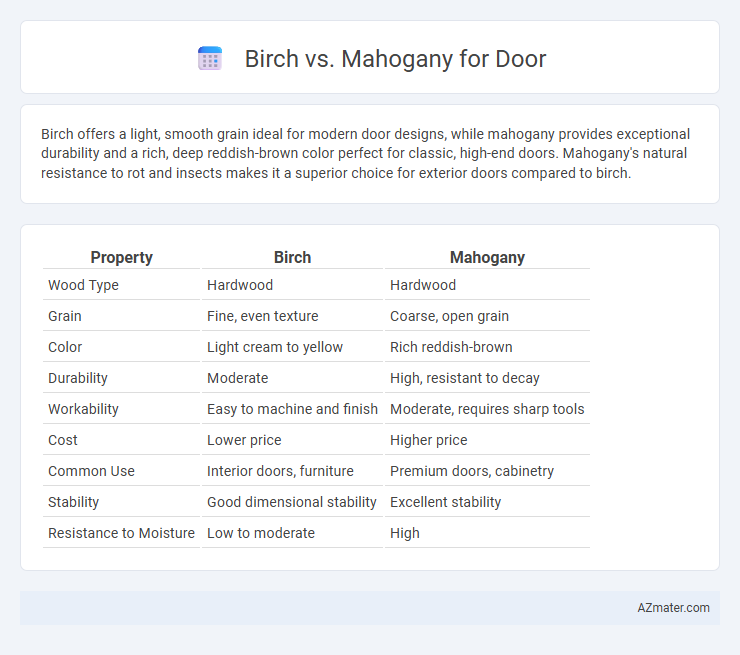Birch offers a light, smooth grain ideal for modern door designs, while mahogany provides exceptional durability and a rich, deep reddish-brown color perfect for classic, high-end doors. Mahogany's natural resistance to rot and insects makes it a superior choice for exterior doors compared to birch.
Table of Comparison
| Property | Birch | Mahogany |
|---|---|---|
| Wood Type | Hardwood | Hardwood |
| Grain | Fine, even texture | Coarse, open grain |
| Color | Light cream to yellow | Rich reddish-brown |
| Durability | Moderate | High, resistant to decay |
| Workability | Easy to machine and finish | Moderate, requires sharp tools |
| Cost | Lower price | Higher price |
| Common Use | Interior doors, furniture | Premium doors, cabinetry |
| Stability | Good dimensional stability | Excellent stability |
| Resistance to Moisture | Low to moderate | High |
Introduction: Birch vs Mahogany Doors
Birch doors offer a light, fine-grained texture that enhances modern and minimalist interiors, while mahogany doors provide rich, deep reddish-brown hues prized for their durability and classic elegance. Birch is generally more affordable and easier to work with, making it suitable for budget-conscious projects, whereas mahogany's natural resistance to decay and warping ensures long-lasting performance in exterior door applications. Choosing between birch and mahogany depends on aesthetic preferences, budget constraints, and the desired longevity of the door.
Key Physical Differences
Birch doors are known for their fine, even grain and light color, offering a smooth surface that is easy to stain and paint, making them versatile for various design styles. Mahogany doors feature a rich, reddish-brown hue with a straight, interlocked grain pattern, providing exceptional durability and resistance to warping or swelling. The density of mahogany is higher than birch, resulting in a heavier, more robust door ideal for exterior applications requiring long-lasting performance.
Appearance & Grain Patterns
Birch doors exhibit a smooth, fine-grained texture with subtle, uniform patterns that offer a clean and contemporary aesthetic. Mahogany features a rich, reddish-brown hue with distinctive, interlocking grain patterns providing a luxurious and classic look. The contrast between birch's lighter, more consistent appearance and mahogany's deep, varied tones influences the choice based on desired style and ambiance.
Durability and Strength Comparison
Birch doors offer moderate durability with a Janka hardness rating around 1260, making them resistant to wear and suitable for interior use. Mahogany doors possess superior strength and durability, boasting a Janka hardness close to 2200, which ensures excellent resistance to dents and warping, ideal for exterior applications. The denser grain structure of mahogany also provides enhanced stability and longevity compared to the lighter, less dense birch.
Cost and Affordability
Birch doors typically cost less than mahogany, making them a more affordable option for budget-conscious homeowners. Birch offers good durability and a smooth finish at a lower price point, while mahogany is a premium hardwood with higher costs due to its rich grain and natural resistance to decay. Choosing birch provides significant cost savings without sacrificing essential quality for interior door applications.
Maintenance and Longevity
Birch doors offer moderate maintenance with periodic sealing and refinishing to prevent warping and discoloration, making them suitable for interior use with a lifespan of 15 to 25 years. Mahogany doors require minimal maintenance due to their natural resistance to decay and insects, often needing only occasional polishing, which contributes to a longer lifespan exceeding 40 years. The dense grain and durability of mahogany make it a preferred choice for exterior doors where longevity and minimal upkeep are critical.
Environmental Impact and Sustainability
Birch doors offer a more sustainable option due to their faster growth rate and abundance compared to mahogany, which is often sourced from slow-growing tropical forests with higher environmental concerns. Harvesting mahogany contributes to deforestation and habitat loss, while birch plantations can be managed more sustainably with less ecological disruption. Choosing birch reduces carbon footprint and supports sustainable forestry practices, making it an environmentally preferable choice for door materials.
Suitability for Interior and Exterior Use
Birch is suitable for interior doors due to its fine grain and smooth finish, which allows for easy painting and staining, while its moderate hardness ensures durability within indoor environments. Mahogany's natural resistance to moisture, decay, and insects makes it highly suitable for exterior doors, providing long-lasting performance and rich, warm aesthetics in outdoor conditions. Both woods offer stability, but mahogany outperforms birch in weather resistance, making it the preferred choice for exterior applications.
Popular Uses in Home Design
Birch wood is widely favored for interior doors due to its fine grain and light color, making it ideal for modern and Scandinavian home designs that emphasize brightness and simplicity. Mahogany is popular in luxury and traditional homes, prized for its rich, deep reddish-brown hue and superior durability, often used in exterior doors and high-end cabinetry. Both woods offer distinct benefits: birch for affordability and versatility, mahogany for elegance and strength, influencing homeowners' choices based on aesthetic preferences and functional needs.
Conclusion: Which Wood is Best for Your Door?
Birch offers superior durability and a smooth, fine grain ideal for modern door designs, while mahogany provides exceptional resistance to rot and a rich, classic aesthetic favored in traditional settings. For exterior doors requiring weather resistance and longevity, mahogany is typically the best choice due to its natural oils and strength. Birch suits interior doors well when budget-friendly, strength, and a clean appearance are priorities.

Infographic: Birch vs Mahogany for Door
 azmater.com
azmater.com